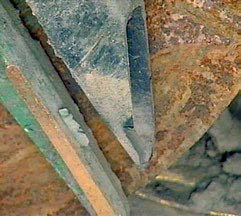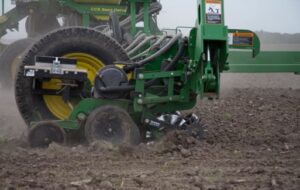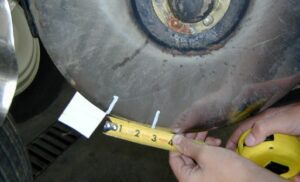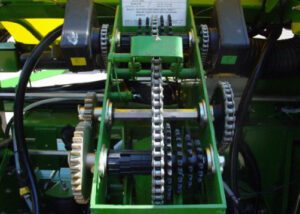At AgVenture, we believe that what you do at planting determines what you will produce at harvest. When you work with your locally owned and operated AgVenture Independent Seed Company, you will add an experienced Yield Specialist to your circle of influence that wants to help you increase your bottom line. The following steps for planter preparation are just one piece of achieving your harvest goals, but as in any race, how you start is reflective of how you will finish.
 Planter Leveling
Planter Leveling
For proper disc cutting action, seed delivery, planting depth accuracy, and press wheel action, planters need to run slightly uphill, particularly as they age and the parallel linkages become worn. Check your planter for its levelness. If the planter is running downhill, it may require adjusting the hitch position.
Parallel Linkages
Parallel linkages wear over time, which can lead to excessive movement of the row unit. Bushing wear will tend to make a row unit plant slightly shallower with more tendency for erratic seed distribution. With your planter raised in the air stand behind each row unit and push up and side to side. If you find that the row unit moves excessively, it is time to replace the parallel linkage bushings.
 Opening Discs
Opening Discs
Sharp cutting double-disc openers can either make or break a planter. A business card can be used to determine if the discs have the necessary 2 inches of cutting edge contact (see photo). The V-trench they form is critical for good seed-to-soil contact and uniform emergence. As disc openers wear, they will no longer form a firm cutting point. This can lead to an irregular furrow, shaped like a “W” instead of a “V” resulting in variable seed depth placement and a lack of seed to soil contact. Discs should be replaced when wear exceeds factory specifications, which is typically when they have lost ½-inch or more of their original diameter. A good visual indicator that discs need to be replaced is when the original bevel on the edge of the discs is gone.
Depth Gauge Wheels
Depth-gauge wheels should be checked to make sure that they turn freely, move up and down easily, and run tightly against the opening discs. This is important to ensure that soil doesn’t flow between the wheels and the opening discs and into the seed trench, which can result in irregular seed placement and planting depth variability. Yearly inspections will tell you if the gauge wheel arm bushings are worn and if the wheels need to be shimmed in against the double disc openers.
Seed Tubes
 Inspect seed tubes and vacuum for obstructions, leaks, and loose fittings, and continue to do this regularly throughout spring planting season. Clean seed tube sensors routinely, and make sure to adjust vacuum pressure according to seed size and shape.
Inspect seed tubes and vacuum for obstructions, leaks, and loose fittings, and continue to do this regularly throughout spring planting season. Clean seed tube sensors routinely, and make sure to adjust vacuum pressure according to seed size and shape.
Check your seed drop tubes to be sure they are free and clear of any obstructions, and make sure that they are not worn by your double disc openers. Rough edges caused by wear can alter your planter’s seed
drop accuracy. Any hindrance or obstruction that interferes with seed drop can result in erratic seed distribution, even though meters are functioning perfectly. If seed tubes are worn, they should be replaced. If the planter is equipped with seed firmers, they should also be checked for wear and replaced if necessary.
Meters
Meters should be taken apart before each planting season for cleaning and to check parts for wear. Finger pick-up metering units should be recalibrated after 100 acres have been planted per row unit. Confirm that all seals on vacuum meters are in working order and seed discs are flat and not warped. Double check the clearance between the seed disc and the housing to prevent vacuum leaks. Inspect any belt or brush within
the meter, and in high-speed delivery systems, for wear and misshapen bristles or paddles. It is also important to check the bowl tension on John Deere ExactEmerge™ planters. If the bowl tension is too loose, seeds may not end up getting to the brush belt for delivery to the seed furrow.
Coulters and Row Cleaners
Coulters and other attachments can impact seed to soil contact, especially with heavy residues. Coulter depth and sharpness are important to allow residues to be cut cleanly rather than crimping and pushing them into the seed furrow. Most coulters should be set to run about 1/4 inch above the depth of the double-disc openers. Be sure that coulters and residue attachments are aligned properly with the double-disc planted
too deep and double disc openers not turning properly.
Make sure row cleaners gently sweep residue – you don’t want to move soil, just residue. Watch the row cleaners running. Fixed row cleaners shouldn’t turn constantly; they should gently turn sporadically, especially through areas of thick residue. Floating row cleaners should maintain constant contact with the ground, flowing the contours and providing a clean and consistent path for the depth gauge wheels to follow.
 Closing Wheels
Closing Wheels
For closing wheels to perform properly, it is important to ensure that they are aligned with the opening discs. To check alignment, set the planter on the ground and pull ahead about 5 feet. Look at the mark left behind the planter by the double disc openers. The mark should run right down the centerline between closing wheels. If a closing wheel is running too close to the seed furrow, adjust the closing wheels to bring it back to the center.
 Chains and Sprockets
Chains and Sprockets
Check all chains, sprockets, and shear pins for wear and proper tension. If they are worn or chain links are stiff, the chain should be replaced. Make sure chains are lubricated properly.
Technology Check
Check all wiring harnesses, ensure all wiring is connected and in working order. Consider gathering loose cords with zip ties. For all add on equipment, check all electric sensors, down force compressors etc.
Review all monitors, remove old prescriptions. Load VRS planting scripts from Granular Insights prior to planting and ensure planter is accepting the prescription. Utilize agronomic tools from Granular Insights like population charts for hybrids based on seed price, yield environment, and commodity price. Scan corn seed batch tags for final planter settings to optimize seed drop. Have your planting plan pre-loaded into the monitor and onto all employee smart phones for simple stress-free planting.
Safety Check
Perform a safety check on all planting equipment to make sure lights and signals work properly so you don’t risk accidents when moving from one farm or field to another. Ensure that all farm equipment has the appropriate slow moving vehicle signage. Clean windows to ensure operators can see clearly. Ensure the hitch pin is secure and safety chain is attached, especially for road travel.
These quick tips should provide a solid foundation to get your planting season started on the right foot. Before you get into the field, talk to your local AgVenture Yield Specialist to put together a planting plan specific to your operation. Preparing your planter for spring planting is just one step to producing more bushels in the fall. Our team is ready to set and achieve goals with you this season.
Find your locally owned and operated Indpendent Seed Company.
The foregoing is provided for informational use only. Please contact your sales professional for information and suggestions specific to your operation. Product performance is variable and depends on many factors such as moisture and heat stress, soil type, management practices and environmental stress as well as disease and pest pressures. Individual results may vary.



